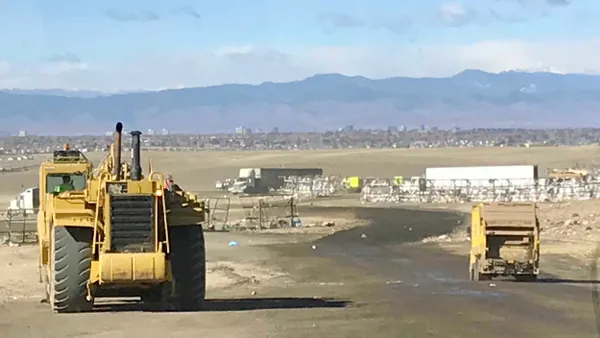Dive Brief:
- The U.S. Environmental Protection Agency is proposing to allow utilities to continue dumping coal ash into ponds that are scheduled for closure, and allow some to remain unlined.
- The proposed changes, filed Wednesday, would exempt some facilities from lining their basins with plastic if they met certain protective standards, despite a D.C. Circuit Court of Appeals ruling in August 2018 that the Obama administration's rules were not strict enough on liners. EPA made the decision based on industry feedback, according to its proposal, despite concerns from environmental advocates.
- Under the proposal, utilities could also potentially lengthen the closure timeline for a coal ash pond. The proposal is expected to save industry between $41 million and $138 million per year, according to EPA.
Dive Insight:
Wednesday's proposal from the EPA sides with industry on its greatest contention with environmentalists — whether a coal ash pond sufficiently protects groundwater and the environment if it is not composite (plastic) lined.
The debate centers around which engineering methods best prevent the heavy, watered down ash from leaching into surrounding groundwater and in some cases reaching major waterways. Preliminary results from a Duke University study released this fall suggested the potential impacts of contamination exposure may be more severe than previously thought, and suggested monitoring requirements should be heightened.
The D.C. Circuit ruling found that Obama-era coal combustion residual (CCR) rules, established in 2015, did not require sufficient lining protections, saying that clay-lined or unlined basins posed different risks than plastic lined basins.
EPA disagreed in response to the court's ruling. "EPA received reports from industry groups and individual companies claiming that some surface impoundments that would now be required to retrofit or close have an engineered liner or underlying soils that are equivalent or even superior to the performance of the liners required by the 2015 CCR rule," the agency said in its proposal.
Ultimately, EPA argued, even if the bottom of the pond does allow some of the waste to leach out, the facility is still protective of human health and the environment if the engineering of the basin liner is strong enough that "the volume of leachate that can be transmitted to the underlying aquifer over time is so small that it will not adversely affect ground water."
If these changes go into effect, facilities will be able to submit an alternative liner demonstration to the EPA, proving their engineering is as effective at protecting human health and groundwater than the heavier liners.
"[T]hese common-sense changes will provide the flexibilities owners and operators need to determine the most appropriate way to manage CCR and the closure of units based on site-specific conditions," EPA Administrator Andrew Wheeler said in a statement.
Essentially, what the EPA is doing is providing a record to broaden the definition of what kind of line can be sufficiently protective, Jim Roewer, executive director of the Utility Solid Waste Action Group told Utility Dive.
The D.C. Circuit "ruling basically found the record that they had didn't support defining a liner as two feet of compacted clay. What the agency has done is developed a record upon which a definition of alternative liner systems could be established that looks at the functionality" of the liner and whether it provides the same protections as a plastic liner, said Roewer.
Under the proposed rule, utilities would need to submit an alternative liner demonstration within 13 months of the final rule, with the possibility of extensions. Roewer and the EPA both noted there would likely be few basins able to meet the alternative liner requirements.
But environmentalists said the proposed changes are in direct contradiction to the D.C. Circuit Court of Appeals and will not sufficiently protect groundwater.
"EPA is proposing that there be an alternate liner, but that is really no liner at all," Lisa Evans, senior attorney at Earthjustice, told Utility Dive. "It's weakening the regulation and building this fiction that there is somehow some sort of liner that's really not an engineered, manmade liner." Earthjustice is still determining what specific ponds may be able to apply for this demonstration.
The proposal would also allow utilities to continue disposing ash in some ponds even after the pond has been scheduled for closure. Ponds will still be able to actively take in ash if the ash remains under a certain volume — and this includes ponds located in unstable areas, such as in a seismic zone or within five feet of waterway.
Under a November rule proposed by the EPA, unlined basins will have to close by August of this year, with room for extensions. In an earlier rulemaking, EPA had moved the closure dates from April 2019 to October 2020.
"The agency appropriately recognizes that there needs to be a mechanism for unlined units," said Roewer. "They appreciate the fact that you can only go as as fast as technically feasible and in some cases you're going to have to have the ability to extend the deadline."
But environmentalists say there should be greater urgency in closing unlined ponds.
More than 90% of EPA-monitored coal ash facilities in the U.S. are reporting unsafe levels of one or more pollutant in surrounding groundwater, an Earthjustice and Environmental Integrity Project report found in March of last year.
"Common sense would say the least amount of ash that's in that problematic pit would be the best protection going forward of the environment," said Evans. "But it is convenient and cheaper for utility to fill up that closing pit to the largest extent possible before placing a cap over it."











